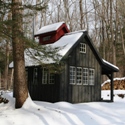
Colin,
Thanks for the info on the fittings. I e-mailed the Shurflo tech group and it doesn't sound like their 120 volt motors will last very long....definitely not continuous service. They said they wouldn't expect a pump to last more than 3-4 months in continuous service. It didn't sound like they expected their 12 volts to do any better. I guess I'll check the Aquatec pumps again.
Leader 1/2 pint - Kawasaki Mule - Smoky Lake Filter Bottler
24 GPH RO, 2 1/2 x 40 NF3 (NF270), 140 GPH (Brass with no relief valve ) ProCon pump
2013 - 44 taps - 16 gallons syrup, 2014 - 109 taps - 26 gallons syrup
2015 - 71 taps - 13.5 gallons syrup, 2016 - 125 taps - 24.25 gallons syrup
2017 - 129 taps - 17.5 gallons syrup, 2018 - 128 taps- 18 gallons syrup
2019 -130 taps - 18.5 gallons syrup, 2020 ~125 taps-19.75 gallons syrup















 Reply With Quote
Reply With Quote

